Investigating the Galaxy Nexus LTE Signal Issue
by Brian Klug on December 19, 2011 8:24 PM EST- Posted in
- Smartphones
- Verizon
- LTE
- Droid Charge
- Mobile
- galaxy nexus
- Android 4.0
It seems that each time an LTE handset comes out, there’s invariably some perceived issue with connectivity and stability. This time, focus is being placed on Verizon’s CDMA/LTE variant of the Galaxy Nexus, and the issue surrounds LTE connectivity robustness compared to the other LTE handsets out there.
I’ve been running battery life tests on our LTE Galaxy Nexus review unit since release day (a process that takes a considerable amount of time and results in our reviews posting a while behind everyone else’s), but have had some time to run tests and gauge subjective performance. I found that LTE connectivity and performance felt above average, subjectively, and noted that in a tweet. After complaints started to surface, I spent a considerable amount of time reading the threads on XDA and other places around the web trying to discern what the complaints are about. I’ve seen a couple of big misconceptions that I think really get to the heart of the matter.
First off, is some background. The Verizon CDMA/LTE Galaxy Nexus (codename “mysid”) uses a combination of Samsung CMC221 and Via Telecom CBP 7.1 for LTE and CDMA 1x/EVDO connectivity, respectively. This is virtually identical (unsurprisingly) to the Droid Charge, which used a CMC220 for LTE and the same CBP 7.1. The CMC22x family is UE Category 3, which currently is the highest for shipping devices and means it can handle up to 100 Mbps downstream with 20 MHz FDD. To date, all of the LTE basebands in Verizon LTE devices have been UE category 3 with the exception of Motorola’s devices, which are all UE category 2, but I digress. We’ve reached out to Samsung Semiconductor about what’s changed between CMC220 and 221, but doubtless the changes improve connection stability and reliability.
Speeds thus far have also been excellent. I’ve squeezed in 183 speedtests between battery life testing, and have seen some of the fastest LTE connectivity out of the Galaxy Nexus to date. After testing so many Motorola LTE devices with UE Category 2 modems, it’s refreshing to see this kind of performance out of a UE Category 3 device.
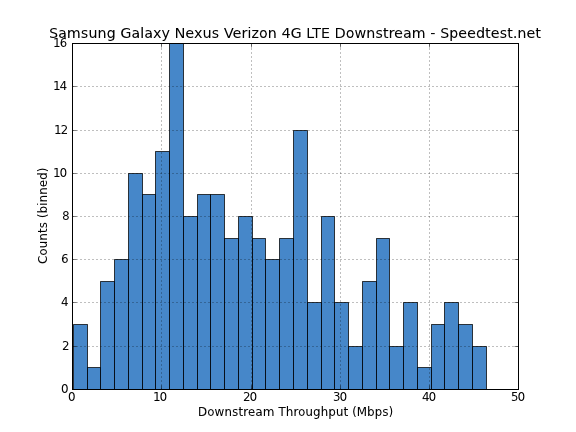
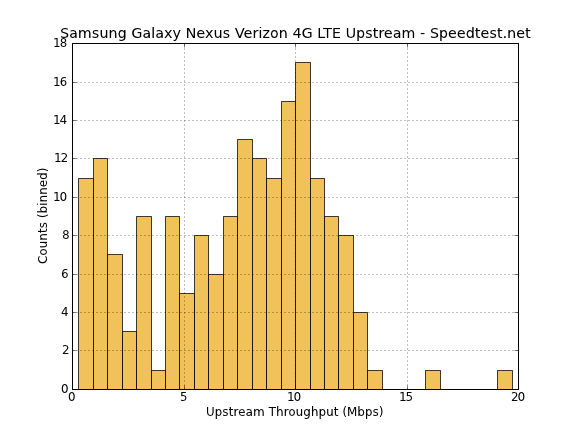
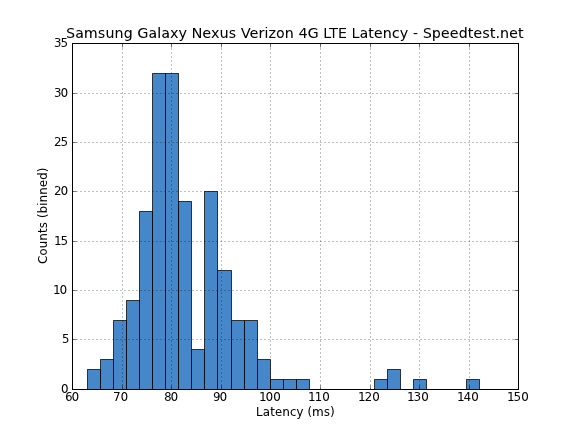
The issue that most people talk about centers around signal strength, and this is where a few misconceptions kick in. I’ve gotten a few emails and tweets and read pages on forums where people are implicitly comparing CDMA2000 1x/EVDO field strength to LTE field strength. The issue here is that on basically all of the LTE/CDMA Verizon handsets, the field under “Signal Strength” in about refers to EVDO signal strength, and not LTE signal strength. The two aren’t comparable at all for a host of reasons - different spectrum (800 MHz and 1900 MHz for 1x/EVDO as opposed to 700 MHz for LTE), and different cells (there’s some correlation, but not every Verizon base station has LTE onboard). The end result is that if you’re comparing 1x/EVDO signal strength to LTE signal strength, you’re making an absolutely meaningless apples to oranges comparison.
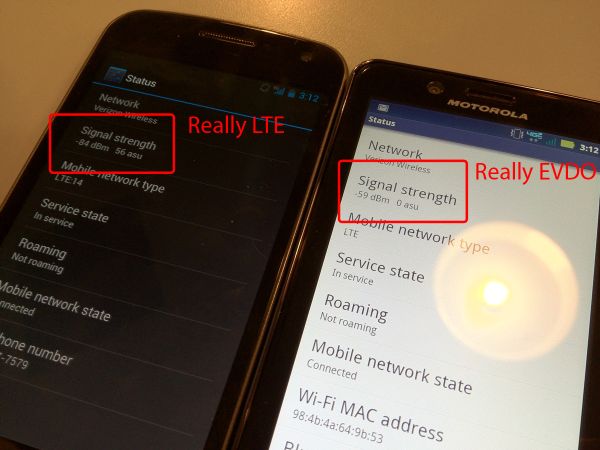
This is not a valid comparison - LTE versus EVDO signal strength
The Galaxy Nexus (and really just Android 4.0) now correctly reports and accommodates LTE by reporting its signal strength under “About->Status” and visualizing that as bars appropriately. Switch to EVDO on the Galaxy Nexus and signal strength appropriately changes to reflect an entirely different air interface’s signal strength. It’s nice to see people using dBm instead of bars when possible (which are effectively meaningless as a comparison metric), but now that there are multiple air interfaces on handsets, we have to be explicit about what numbers we’re actually comparing.
This reporting is a problem I’ve talked about at length in more than one LTE handset review, and to date I only know of ways to show LTE signal strength and channel quality on a few handsets. Samsung’s Droid Charge (courtesy Samsung’s excellent ServiceMode application viewed through *#0011# after some unlock trickery) and the Bionic (through logcat and grepping for the radio signal status daemon) report LTE field strength, but only if you dig for them.
Comparing LTE Signal Strength the Right Way
So how does the LTE Galaxy Nexus compare to the Droid Charge and Bionic, the two handsets we can actually view LTE signal strength in dBm on? Very closely as a matter of fact.
I have a Bionic kicking around which has to go back very soon, but fired up logcat and put the Galaxy Nexus next to it. The Bionic reports signal strength pretty constantly whereas in Android 4.0 the number has some hysteresis, but here the numbers are pretty darn close, with the Bionic hovering between -91 and -95 dBm, and the Galaxy Nexus reporting an average of -92 dBm.
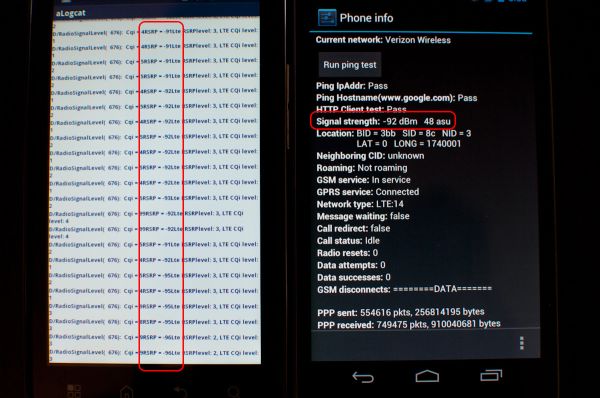
Left: Motorola Droid Bionic (logcat showing LTE signal strength), Right: Galaxy Nexus
Since the Droid Charge is the only other handset I know how to show LTE signal strength on, I tracked a friend down at a local cafe with one and fired up service mode. Again, what’s shown under “About->Status” on the Droid Charge is actually EVDO signal strength. Here the Galaxy Nexus shows -107 dBm and the Droid Charge shows -108 dBm.
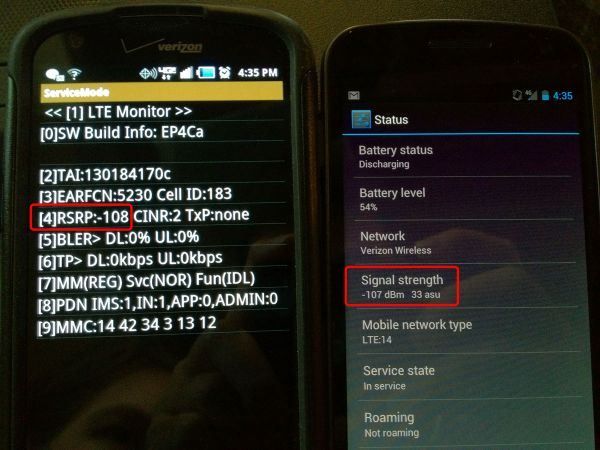
Left: Samsung Droid Charge (ServiceMode) Right: Galaxy Nexus
The Droid Charge is another hilarious example of why you can’t compare bars at all, as the Charge shows a positively laughable 4 out of 5 bars in an area with very low LTE signal strength, whereas the Galaxy Nexus (moreover, Android 4.0) has a very conservative and realistic strength to bars mapping. Carriers love to make things out to be better than they really are, however, and the result is this kind of hilarious visualization which portrays LTE signal as being much better than it really is if you stare at bars all day.
Verizon confirming though a tweet that there’s some sort of signal issue affecting the Galaxy Nexus confuses me, since from my perspective there isn’t any issue at all. The only real issue that exists is that the Galaxy Nexus (and really just the stock Android 4.0 signal strength to bars mapping) doesn’t line up with what Verizon has shipped on other devices, thus leading people to make apples to oranges comparisons and imagine an issue. I wager that some of this confusion is also compounded from the number of Verizon customers that are just now getting their first LTE handset with the Galaxy Nexus. It might be surprising to discover that LTE coverage right now isn't nearly as good as 1x/EVDO, but these things will improve as the carrier's LTE rollout continues. The other big disclamer is that I haven't fully investigated 1x/EVDO performance on the Galaxy Nexus, but this will end up being virtually identical to the Droid Charge.
There’s a CDMA and LTE baseband update coming with the LTE Galaxy Nexus’ 4.0.3 update as shown above, but this will likely do more to address connection stability than change the way anything is reported. Given how much attention this has gotten, however, I would not be surprised to see Google make a change to its signal strength to bars mapping for LTE and placebo away an issue that never really existed to begin with. That's also an unfortunate change, since from my perspective the Galaxy Nexus is one of the first handets that doesn't have an unrealistic mapping. In the meantime, we're still working on our Galaxy Nexus review where we'll take a complete look at the LTE/CDMA and GSM/UMTS Galaxy Nexii.
Update:
As predicted, Verizon has made a statement to The Verge and Computerworld stating that there's nothing wrong with the RF performance characteristics or baseband firmware on the LTE/CDMA Galaxy Nexus. Instead, they will upstream some changes to Android to make the device report its bars visualization in line with the rest of its 4G LTE hardware portfolio.
"[Verizon] will adjust the signal strength indicator to more closely match other Verizon Wireless devices.


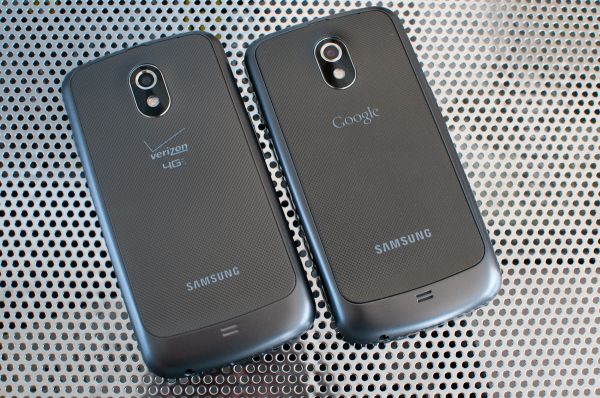









154 Comments
View All Comments
dcdttu - Tuesday, December 20, 2011 - link
I compare CDMA (3G) to CDMA (3G) with my GN and a Charge, and get very different reception results. I've tested multiple times at multiple locations, the GN is always lower by quite a bit. Also, my friend's Charge doesn't drop signal/calls all over the city like me.Davest - Tuesday, December 20, 2011 - link
No, you're wrong...that's not the real issue. Bottom line...my GNex, with total consistency, fails to connect to the LTE network in places where my Bionic, with total consistency, could. I'm not talking about bars...I'm talking about the ability to connect to the network.Garstud - Wednesday, January 4, 2012 - link
Same exact situation with me. With my bionic i never lost 4g at work, now with the nexus i constantly bounce in and out of 4g.LoneWolf15 - Tuesday, December 20, 2011 - link
Do note that in the past week, the Bionic has had significant upgrades to its software, which include the baseband.I do not know which system version Brian used, but it may affect the outcome. Version 5.5.893 was released the middle of last week, squashing a large number of Bionic issues, and several people (myself included) received a 5.9.901 update this week that the community is still debating, as neither Verizon or Motorola have released any information about it.
Brian Klug - Tuesday, December 20, 2011 - link
I used the pre-update version (I was concerned for a while that the update would remove Motorola's dumping of signal data out to logcat), but it shouldn't change things too much. The update is a bit hard to get a read on though.-Brian
dcdttu - Tuesday, December 20, 2011 - link
I am sitting at my desk with a Charge and Nexus. Both are set to EVDO-only, thus their 'bars' and dBm are both reading for EVDO. My work is a 3G and 4G tower for Verizon. His Charge is reading in the -60's to -50's, very good and what you would expect for a phone next to a tower. My Nexus reads in the -70s to -80s, what you would expect from a phone about a mile or so from a tower. Very different.I believe that 4.0.2 broke the reception for some phones, but not all. I drop service and reception all the time in Austin, TX. But its just a theory.
Also, this is affecting my 3G service as well, not just 4G.
Either my Nexus has an issue, or Verizon doesn't have a good signal or signal at all over most of the Austin area, which I don't believe because my friends with other Verizon phone have no issues.
turbon50 - Monday, December 19, 2011 - link
This is a real problem. Try going into an area that has really bad reception with a phone that is known to have a good antenna, yet barely has reception in this area. Then try make a call or surf the web with the nexus. You wont be able to as I tried this with my droid x. I could make calls and surf the web whereas the nexus was useless (no calls or web surfing). Hope they fix this soon.Brian Klug - Monday, December 19, 2011 - link
Again, you're making a tacit comparison of LTE signal and 1x/EVDO signal. The two are not equal and you cannot make expectations for how the Galaxy Nexus will fare on LTE based on what the coverage profile with your Droid X (which is 1x/EVDO) was. It's a completely different spectrum and air interface.-Brian
yelnatsch517 - Tuesday, December 20, 2011 - link
I don't quite understand. I thought Turbon50's post meant he was comparing Droid X 1x/EVDO to Nexus 1x/EVDO. Does the Nexus require the user to manually switch to 1x/EVDO?turbon50 - Tuesday, December 20, 2011 - link
No matter how you put it the reception is worst. I turn of 4g so both on 3g and it makes no difference. If you can't make a call, I don't see how any excuse matters. No calls in exact same spot= weaker reception.